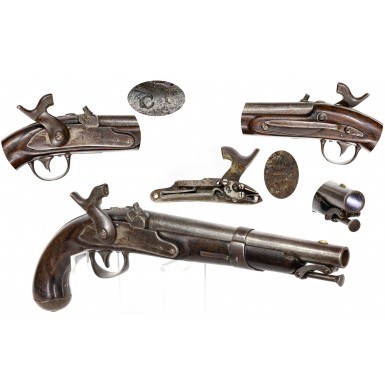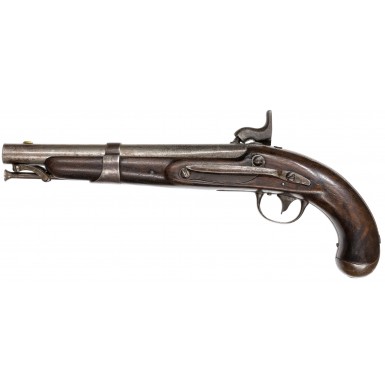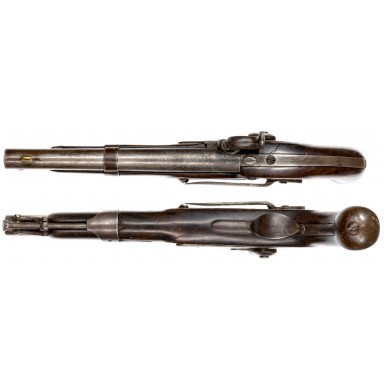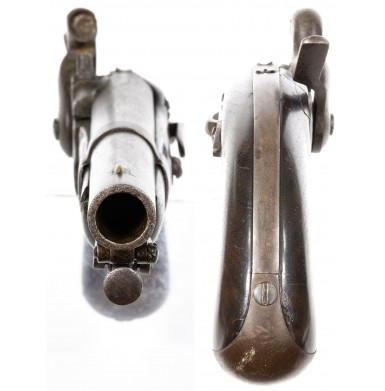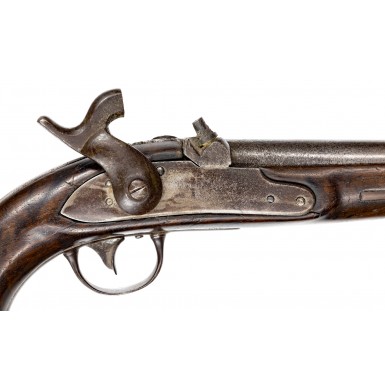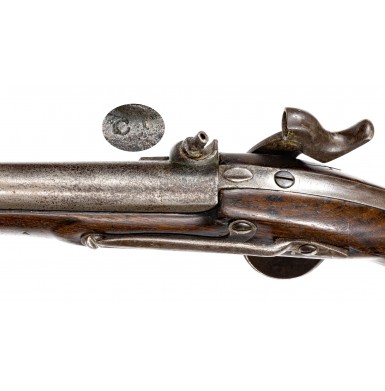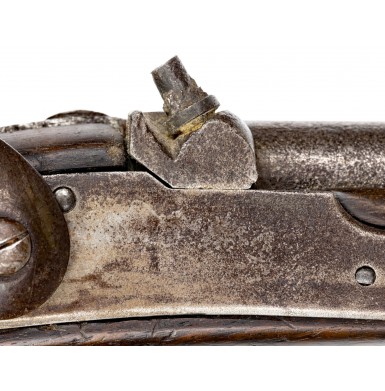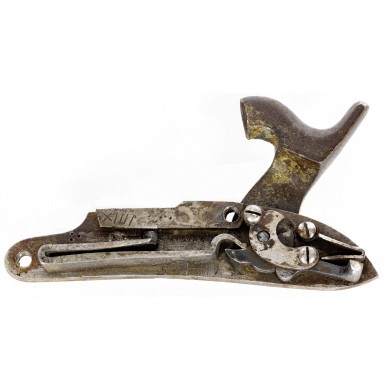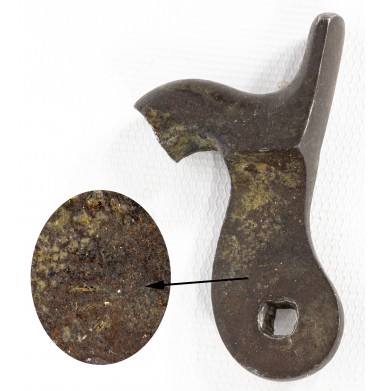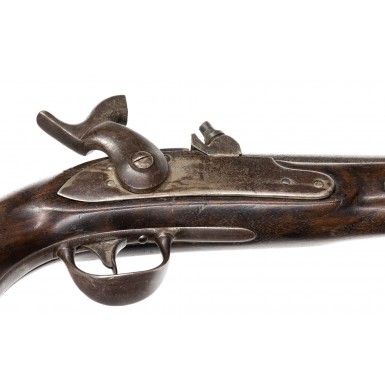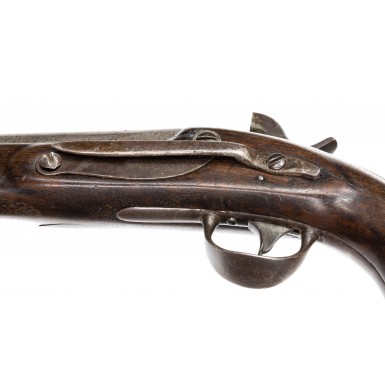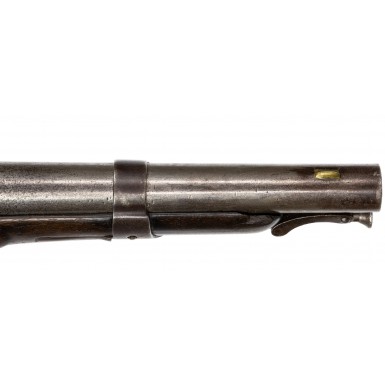Adams of Richmond Confederate Altered US Model 1826 Naval Pistol
- Product Code: FHG-3491
- Availability: Out Of Stock
-
$2,495.00
With the coming of the American Civil War, most of the newly seceded southern states found themselves woefully ill-prepared to field and equip an army to withstand President Lincoln’s intention to suppress the rebellion and re-unite the union by force. Most of the southern states had limited quantities of mostly obsolete arms in their various arsenals and had little (if any) manufacturing to capacity to produce arms. One particular exception to this generalization was the state of Virginia. While the state had a limited number of “modern”, current production percussion rifle muskets, they did have a rather large supply of older flintlock arms in various states of repair, most of which could (and eventually would) be altered to percussion. The state also had the basic structure to establish a state armory to produce small arms, as the old Virginia Manufactory of arms was located in Richmond. This facility had opened circa 1802 to manufacture small arms for the Virginia Militia and had remained in operation for nearly two decades. The authorities in Richmond were soon scrambling to renovate and reopen this facility and with the addition of machinery captured at Harpers Ferry in April of 1861, the old Virginia Manufactory was soon operating as the new Richmond Armory.
The Virginia state government also looked to various contractors to help upgrade their current stores of flintlock muskets, rifles, and pistols to percussion. This had actually been going on somewhat aggressively since about 1858, when the state had started to turn in as many flintlock muskets as the Federal Government would allow under the Militia Act of 1808, to have them replaced by percussion altered muskets. Prior to the war, the state had also contacted some private vendors like Merrill, Thomas & Company to alter existing stocks of arms to percussion, primarily Virginia Manufactory arms that were in store. With the outbreak of the war, the state proceeded to contract with a number of local gunsmiths and makers to alter as many muskets, rifles, and pistols as was practicable. The primary contractors were Thomas J. Adams of Richmond, J.B. (and A.B.) Barrett & Co, William Morgan, F. Persignon, S.C. Robinson and the Union Manufacturing Company. Three smaller contractors also did alterations for the state on a much more limited basis, including J.H. Wells, J.D. Brown, and S. Holbrook. While the majority of the work performed by these contractors was the percussioning of muskets and a few rifles, three of the contractors also performed alterations to single-shot flintlock pistols. These included J.H. Wells of Staunton (later Charlottesville), William Morgan of Petersburg and Thomas J. Adams of Richmond. The total number of pistols altered by the first two gunsmiths is inconsequential, as Wells altered approximately sixteen pistols for the state of Virginia, and William Morgan appears to have only altered six. These numbers were arrived at based upon the amounts paid to the two men, as the average cost charged to alter a pistol or musket to percussion by the various Virginia contractors was $4.00 each. Only Thomas J. Adams altered what can be considered a significant number of pistols for the state, and it is generally believed he altered about five hundred and seventy pistols.
The research presented in Confederate Rifles & Muskets by John D Murphy, M.D. & Howard M. Madaus reveal that three vouchers, numbers 2492, 5165 and 5935 from the state of Virginia show payments to Adams “for altering cav. pistols.” The payments were for $456 on January 1, 1862, $808.50 on May 5, 1862 (noted as “for altering cav. pistols, etc.”) and for $548.68 on June 2, 1862. The total of payments on these vouchers related to pistols is $1,813.18. Murphy & Madaus apparently uncovered some other receipts in the amount of $462, as they note that Adams received at least $2,275.18 in payments related to altering pistols. At an average of $4.00 each, this means that Adams altered approximately five hundred and sixty-eight pistols during the first six months of 1862. Adams did not mark his work, but by examining the handful of similarly altered surviving examples, a typology has been established by Murphy & Madaus by which Adams alterations can be identified. Part of this identification is based upon the fact that some of the alterations appear on Virginia Manufactory pistols, which were made is somewhat limited quantities during the first two decades of the 1800s, and which tended to remain within the state of Virginia, thus suggesting any alterations to those guns were likely performed there as well. The Adams alteration involved the application of a “three faceted bolster” to the breech of the pistol by means of brazing it over the touchhole. The pan, frizzen and all parts related to the flintlock battery were removed, and the accompanying holes in the lock filled. The pan on some pistols was filled with iron to create an even surface to help support the flat bottom bolster. As noted, the bolster has three definitive facets, with a flat bottom, followed by an upward angular turn at its rear, which is followed by another upward to nearly 90-degrees, which forms a fence at the rear of the bolster. Many of Adams’ bolsters also show the shadow of a circle on their face, an artifact of the bolster application process, which used a rod through a hole in the bolster to hold it in place while it was brazed, with the hole subsequently being filled in and brazed closed. A crudely made percussion hammer was added to the original tumbler, and most of these hammers show rudely applied, simple cross-hatching on their spurs, while others were left smooth. As with most alteration work performed on non-interchangeable parts firearms of the period, mating marks were applied to the guns during the process, usually on the inner neck of the hammer, to the inside of the lock, under the barrel (and/or on the rear of the breech plug) and often somewhere on the stock. It is interesting to note that Murphy & Madaus show a number of variations of these marks on altered pistols attributed to Adams, suggesting that either 1) each workman marked his work in his own way, or possibly 2) that Adams was sub-contracting some of the work and the variation in markings is the result of the work be performed at different shops or locations. It is further interesting to note that while most Confederate alterations will show the same mating mark throughout (for example, the Roman numeral IV), many of the Adams alterations will show two sets of mating marks. On some it is believed the other marks are the original assembly marks for the pistol; particularly on the Virginia Manufactory guns, but in other cases it is obvious that the hammer is marked with a completely different mating mark than most of the rest of the gun. I believe that this is again indicative of different workmen doing the work. While one worker may have removed the flintlock parts and applied the bolter, I think a different one was responsible for fitting the hammers to the guns, and he applied his own mating marks. This is similar to British Ordnance contract pistols from the mid-18th through early 19th century that often show two different sets of mating marks, one set for overall assembly and one related to the assembly and fitting of the lock.
Little is known of Thomas J. Adams’ history prior to working as a contract gunsmith for the Confederacy. According to Murphy & Madaus, Adams had been employed as a gunsmith prior to secession by James Walsh of Richmond, a firearms and sporting goods dealer located at 60 Main Street in Richmond. The 1860 Census shows that T.J. Adams was a resident of the 1st Ward of Richmond in Henrico County, was aged 22 years and was employed as a gunsmith. He resided in a Boarding House owned and operated by Ellen Adams (age 42 and possibly his mother), and the other residents of the home included Mary, Julia C., and William C. Adams, aged 23, 20 and 17 respectively. It is likely that these were Thomas’ brother and sisters. Interestingly, his 17-year-old brother is listed as blacksmith. Other residents of the boarding house include J.C. Walsh (38) who was also a blacksmith, his wife Emma, and four Walsh children ages 5, 9, 11 and 12. Six other residents are also listed in the boarding house, including S. Gregory, a 21-year-old blacksmith, James Manders a 21-year-old clerk, William Lewis, and Joseph Lumpkins (26 and 20 respectively) who were both listed as carpenters and Edward Gill, a 23-year-old merchant. From the interesting list of residents, it appears that most (if not all) were probably somehow working for, or in, the Walsh establishment. Examination of existing examples that conform to the Thomas Adams systems of alteration and assembly marking indicate that he performed this work to both Virginia Manufactory pistols as well as US Model 1836 contract pistols by R. Johnson and A. Waters that were acquired by Virginia under the Militia Act of 1808. He probably also performed the alterations on some US Model 1819 contract pistols by Simeon North, as this was the other pattern of flintlock pistol that was delivered to Virginia in some quantity during the first half of the 19th century. A third potential group of pistols to be altered would have been those captured from Federal facilities inside the state of Virginia. A total of 6,907 pistols were received by the state between 1823 and 1848 under the Militia Act of 1808, of which it is generally believed that most of the 3,657 pistols delivered between 1823 and 1837 were of the Model 1819 contract pattern with the balance of 3,250 being of the Model 1836 pattern. To date only a handful of the estimated 570 +/- flintlock pistols altered by Thomas J. Adams have been identified and are known to survive today, making an Adams altered pistol an extremely scarce and desirable early war Confederate alteration.
Offered here is an about VERY GOOD condition example of a Thomas J. Adams Altered Confederate Cavalry Pistol. The alteration is performed on a US Model 1826 Flintlock Navy Pistol and to my knowledge is the first of these guns to appear with an Adams style alteration. The US Model 1826 pistol was produced in limited quantities for naval contracts from the mid-1820s through 1831. Simeon North produced 3,000 of the pistols between 1826 and 1829 and W.L. Evans produced a much smaller number, estimated at about 1,000, between 1830 and 1831. These single shot smoothbore flintlock pistols were iron mounted with a captive ramrod and due to their intended naval use incorporated a belt hook on the reverse of the stock. The guns were .54 caliber and had nominally 8.625” round barrels that were secured by a single spring-retained barrel band and a screw through the breech plug tang, which was of an extended to form a backstrap that reinforced the grip. The guns were browned with color casehardened locks. The only brass components were the brass flash pan and the front sight. It is likely that this gun was acquired when the Virginia Militia took over the Gosport (Norfolk, VA) Naval Yard on April 20, 1861. It is known that a variety of small arms were acquired for Confederate use at that time, including US Model 1841 Mississippi Rifles that were marked GNY, for Gosport Naval Yard, on their buttplate tangs.
The pistol shows the hallmarks of an Adams alteration. Most importantly it has the classic “three-faceted” brazed on bolster that is associated with the company’s work. In this case the circular shadow of the rod used to hold it in place while it was brazed to the barrel is not visible, but it is not always visible on these guns. The pistol has the classic, roughly made percussion hammer that in this case has a smooth spur. Additionally, the inside of the hammer neck is marked with the large, crudely applied “Roman numeral” reassembly mark found on other altered arms attributed to Adams. In this case the mark is a crude “14”, executed as XIIII. This same mark is crudely cut into the inside of the lock on the lock’s bolster, into the bottom of the barrel and scratched into barrel channel of the stock. As previously noted, some of these guns show multiple assembly marks. In this case, a Roman “2”, cut as II, is found in the backstrap cut-out of the stock and on the underside of the extended breech plug tang. This mark was likely from the original assembly of the pistol when it was produced for the US Navy. The interior of the lock plate also shows two sets of punch dot marks, two on the bolster next to the file slash marks and three on the plate itself.
The lock plate is unmarked and initially I had thought this was due to the plate being machined or buffed during the alteration, as it is not uncommon for Confederate altered US arms to have their markings defaced or removed. However closer inspection shows that there were no holes in the plate for the flintlock battery, thus the plate has always been percussion and is not actually altered from flint itself. Further inspection shows the plate is somewhat crudely made and was apparently made by Adams at the time of the alteration. Why the original flintlock plate was not used is unknown. No proof or inspection marks are visible on the left quadrant of the barrel’s breech, so it is impossible to determine if this was one of the Simeon North made pistols or an Evans contract gun. What appears to be a CT is stamped near the bolster, but this mark is not a known US inspector’s mark so it may be the mark of a workman or inspector in Adams’ factory. Additionally, the location of the mark is not consistent with US contract pistol markings of the period.
As noted, the pistol remains in about VERY GOOD overall condition, especially since it had a service life that spanned the era of the Seminole Wars of the 1830s, the Mexican War of 1846-1848 and the American Civil War, having been altered to percussion by Adams during the first half of 1862. The .54 caliber 8.5625” long, round, smoothbore barrel has a lovely, uncleaned brownish gray patina over all of the exposed surfaces and the iron furniture has a similar matching patina. The barrel is mostly smooth forward of the single barrel band but shows light to moderate pinpricking and light pitting from the band back to the breech and bolster area. There is also the expected light pitting at the muzzle, particularly on the face. The bore of the pistol is dark and dirty and heavily oxidized, showing moderate pitting along most of its length. The lock has the same somewhat mottled brownish-gray oxidized patina as the balance of the pistol and remains in fine mechanical condition, functioning exactly as it should on all positions. As noted, it is assembly marked to the gun but appears to have been made by Adams and was never a flint lock. The belt hook on the reverse of the stock is crudely made and shows numerous rough tool marks, suggesting it was made for the gun as well, and not at the time of manufacture for the navy. The patina of the hook matches the pistol perfectly and it is certainly from the period of use in my opinion. Again, this appears to be a southern-made part. Finally, swivel ramrod in the channel under the barrel appears a period replacement that is also somewhat crudely made in comparison to a US contractor produced rod. The button head is not quite the same size and shape as that on the contractor produced rods and the reverse end is solid and threaded for accessories. The end is not large enough to provide enough friction to keep the rod in place, so it will slip out of the channel if the pistol is pointed down. The large number of period-replaced parts of marginal quality is not an uncommon feature on a Confederate refurbished gun.
The stock of the pistol rates about GOOD to NEAR VERY GOOD. The stock has been sanded at some point during its life and as a result the sharp edges are somewhat rounded and there is not visible inspection cartouche on the counterpane. The stock shows moderate wear and several old cracks and some chipped loss. There is a hairline crack at the tail of the lock mortise, and two cracks at the upper rear and lower front of the lock mortise area that remain solid and tight and are clearly visible in the accompanying photos. The stock also shows some scratches and scuffs and some chipping at the forend tip. The sanding of the wood has left the backstrap somewhat proud of the wood on the rear of the grip. The stock also shows the usual assortment of scattered bumps, dings and mars from service and use, but no real abuse.
Overall, this is a very interesting and rare example of a Thomas J. Adams Altered Confederate Cavalry Pistol built from a US Model 1826 Flintlock Navy Pistol. According to the information in Confederate Rifles & Muskets by Murphy & Madaus, only five examples of Adams altered US Model 1836 pistols were known at the time the book was written. There were also a handful of Virginia Manufactory pistols with Adams alterations known, but no US Model 1819 and certainly no US Model 1826 Naval Pistols known. Even if the number of altered pistols known today is two or three times the numbers listed by them in 1996, the number of surviving examples is very small. As noted, to my knowledge there are no other examples of a Model 1826 pistol with an Adams of Richmond percussion alteration. With only about 570 of these pistols being altered by Adams during the first half of 1862 and considering the rather paltry survival rate of Confederate made and altered arms, it is not likely that many more of these pistol (which were completely obsolete when the war started) would have survived after the war in the cartridge era. For any serious collector of southern-made and altered arms, this is one of those “must have” items. It is an identifiable alteration from a Richmond gunsmith who only altered a few hundred pistols, and it is a great example of how necessity forced the Confederacy to waste time, money, and resources to alter thoroughly obsolete single shot flintlock pistols to percussion in an attempt to arm their cavalry early in the war. This gun would be a great addition to any Confederate arms collection or display, particularly one that centers on Confederate alterations, Richmond made and altered arms or Confederate cavalry arms. Don’t miss your chance to own really neat example of a scarce Confederate altered pistol, for about the price of a mid-grade Colt revolver.
SOLD
Tags: Adams, of, Richmond, Confederate, Altered, US, Model, 1826, Naval, Pistol

